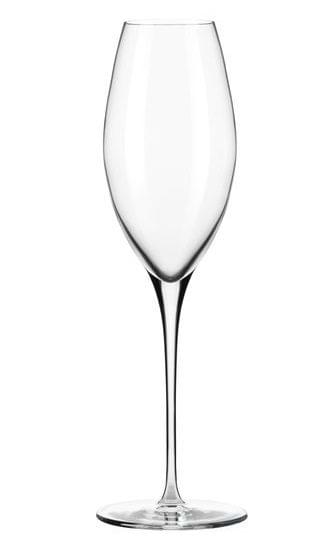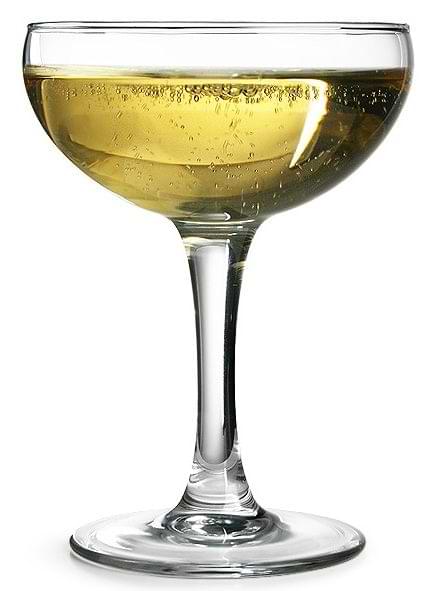
12 September, 2023
Flutes vs. Coupes: A Celebration of Champagne Glass Shapes
The allure of champagne is twofold — it's not just about the effervescent drink but also about the vessel holding it. Over the years, two primary contenders have emerged in champagne glassware: the long, slender flute and the shallow, broad coupe. But which one is superior? And how does each design lend itself to customisation? Let's take a look at the sparkling world of champagne glasses.
The Flute: A Symphony of Elegance

The champagne flute, with its tall, slender stature and iconic silhouette, stands as a symbol of celebration and luxury. However, its omnipresence today culminates centuries of design evolution, driven by aesthetic and functional needs.
The story of the champagne flute begins not with bubbly, but with still wines. In the early days of wine consumption, drinkers used goblets and broad-bowled glasses, much like today's wine glasses or coupes. As sparkling wines gained popularity in the 17th century, especially in the Champagne region of France, the need for a different kind of glass became evident.
The creation of champagne involved a secondary fermentation, introducing a delightful effervescence. However, the wide bowls of the time were inadequate to showcase and preserve these fine bubbles, leading to the birth of the flute design.
As winemaking techniques evolved, wines became clearer, devoid of impurities and sediments. This clarity was something vintners were eager to show off. The flute, with its clear, elongated bowl, was the perfect vessel to display the pristine quality of the wine, while also emphasising the trail of rising bubbles, known as the 'bead'.
The design of the flute began to evolve in the 19th century. The bowl grew taller and more slender, optimising the release of bubbles. The long stem, another distinct feature, ensured that the warmth from the hand didn't transfer to the champagne, maintaining its ideal temperature.
While early flutes were made using various materials, the advent of clear glass and crystal played a pivotal role in the flute's design evolution. The ability to produce transparent and thin-walled glasses further emphasised the visual appeal of champagne. Crystal, being stronger and more refractive than regular glass, became a favourite for high-end flutes, adding to the sparkling experience with its shimmer.
While the traditional flute has maintained its popularity, modern times have seen slight variations in design. Some flutes have a tulip shape, which is believed to further concentrate the aromas, enhancing the sensory experience of champagne consumption. Others have experimented with the stem, creating stemless champagne flutes, which offer a contemporary twist to the classic design.
Advantages:
The design of an object, especially one as refined as the champagne flute, often has multiple layers of intent and significance. When dissecting the champagne flute, three distinct features come to the forefront, each catering to a specific facet of the champagne-drinking experience.
Effervescence Preserved:
One of the primary characteristics of champagne is its effervescence, those mesmerising streams of tiny bubbles racing to the surface. The flute's design is no accident; it's intentionally crafted to enhance this feature.
Reduced Surface Area:
By reducing the surface area with its narrow opening, the flute ensures that the carbon dioxide (responsible for the bubbles) is released more slowly. A wider glass would allow the gas to escape more rapidly, causing the champagne to go flat sooner.
Uniform Bubble Rise:
The elongated design of the flute supports the formation of a continuous bead of bubbles. This provides a visually captivating experience and ensures a consistent texture and mouthfeel with every sip. The consistent rise of bubbles is crucial in the overall tasting experience, offering a gentle tickle to the palate and nose.
Aroma Concentration:
While the bubbles are certainly a highlight, the aroma of champagne, with its delicate notes of fruit, yeast, and sometimes toast or nuts, is equally crucial to the experience.
Focused Aromatics:
The flute's narrow opening acts like a funnel, concentrating the champagne's volatile compounds and directing them straight to the drinker's nose. This design ensures that the intricate bouquet of aromas is not dispersed into the air but is instead captured and intensified, allowing for a fuller appreciation of the champagne's complexity.
Harmonising with Bubbles:
As the bubbles rise and burst at the surface, they release tiny aromatic compounds. The flute's design ensures that this fragrant release coincides with the drinker's inhalation, seamlessly merging the visual, tactile, and olfactory experiences.
Temperature Retention:
Champagne is best enjoyed chilled, typically between 47°F to 50°F (8°C to 10°C). Maintaining this temperature is vital for the drink's character, and the flute's design plays an integral role.
The Protective Stem:
The most evident feature for temperature retention is the flute's long stem. By holding the flute by its stem, the warmth from the drinker's hand is kept away from the bowl. This ensures that the champagne remains at its ideal temperature, preserving its crispness and character.
The Coupe: A Nod to Vintage Glamour

With its shallow, broad bowl and short stem, the coupe is often romanticised in pop culture as the glassware of choice for vintage Hollywood and jazz-infused soirées. But beyond the glam and glitz, the coupe boasts a storied history, interspersed with myths, design evolution, and societal trends.
One of the most tantalising tales associated with the coupe is that it was moulded after the breast of Queen Marie Antoinette, wife of King Louis XVI of France. This was said to be a gesture to toast to the queen and celebrate her figure. However, as intriguing as it sounds, this lore is more fiction than fact. The coupe predates Marie Antoinette's era. There were even claims about other historical figures, like Madame de Pompadour and Empress Josephine, being the muse for the coupe's shape, but these are also largely unsubstantiated.
Historical records suggest that the coupe originated in England around the mid-17th century and was then adopted by the French, becoming a popular vessel for serving both sparkling and still wines. The coupe's wide bowl was initially designed with the intention of allowing the wine's aromas to be enjoyed more easily than with narrower glasses. However, for sparkling wines and champagne, this meant that the bubbles dissipated quickly due to the increased surface area, leading to a flatter drinking experience.
But what might have been a drawback for champagne became an advantage when the age of the cocktail dawned. The early 20th century, particularly the Roaring Twenties, saw the rise of the cocktail culture. The coupe's design was perfect for many classic cocktails as it allowed for easy sipping, and its wide brim was ideal for garnishes and sugar rims. Bartenders and mixologists favoured the coupe for its functional and aesthetic appeal, with its broad bowl displaying the drink's colour and mix beautifully.
The coupe's ascendancy coincided with the golden age of cinema and the rise of Hollywood's influence. On the silver screen, actors were often seen sipping from coupes, embedding the image of the glass with opulence, style, and allure. The allure was not just confined to the screens; the high society and elite parties of the era saw guests clinking coupes as they danced the night away. This association with glam and luxury made the coupe a symbol of elegance and sophistication.
With the advent of the champagne flute in the mid-20th century, the coupe saw a decline in its popularity for serving sparkling wines. The flute's design was better suited for preserving the effervescence of champagne. However, the 21st century has witnessed a revival of vintage trends, and with it, the coupe has made a comeback, especially in cocktail bars and upscale events that want to evoke a nostalgic charm.
Advantages:
Aesthetic Appeal: The coupe undoubtedly brings an old-world charm to the table. It's associated with classic Hollywood, making it a favorite for themed parties and events.
Versatility: Beyond champagne, the coupe is often used for cocktails, especially those that need to be strained, making it a versatile addition to any barware collection.
Drawbacks:
Effervescence Lost: The broad surface area means bubbles dissipate more quickly. While this might not be ideal for purists, some enjoy their champagne less fizzy.
Spillage: The shallow design can lead to easy spillage, especially in crowded settings.
In Conclusion
Both the flute and the coupe have their champions and detractors. While the flute is favoured for its ability to preserve and highlight the champagne's characteristics, the coupe is cherished for its vintage appeal and versatility. Customisation further amplifies the unique attributes of each glass type, transforming them from mere vessels to pieces of art.
Choosing between them is a matter of personal preference and the occasion at hand. Whether you're toasting to new beginnings with an engraved flute or sipping a classic cocktail from a vintage-inspired coupe, the magic lies in the drink and the experience of drinking it.
The Glassware Only Team



